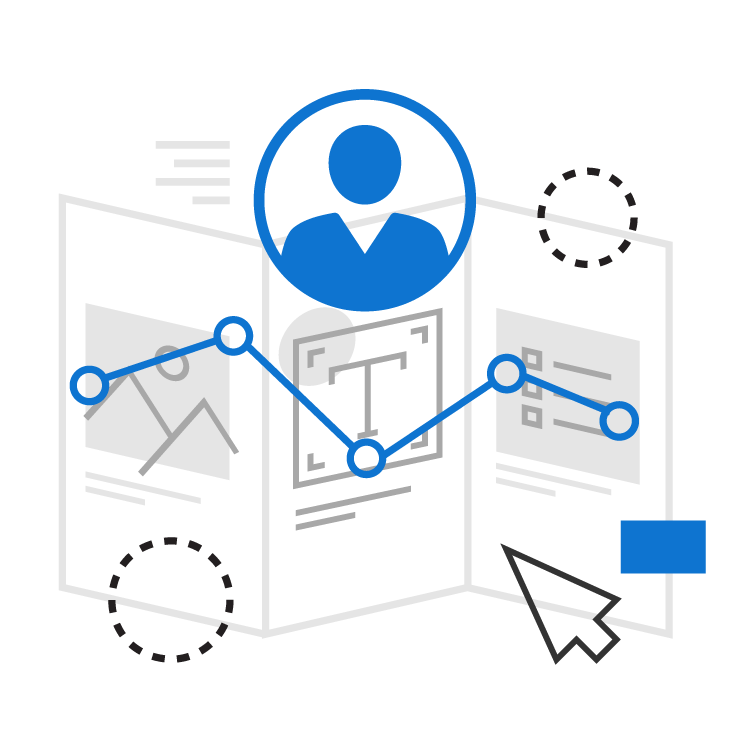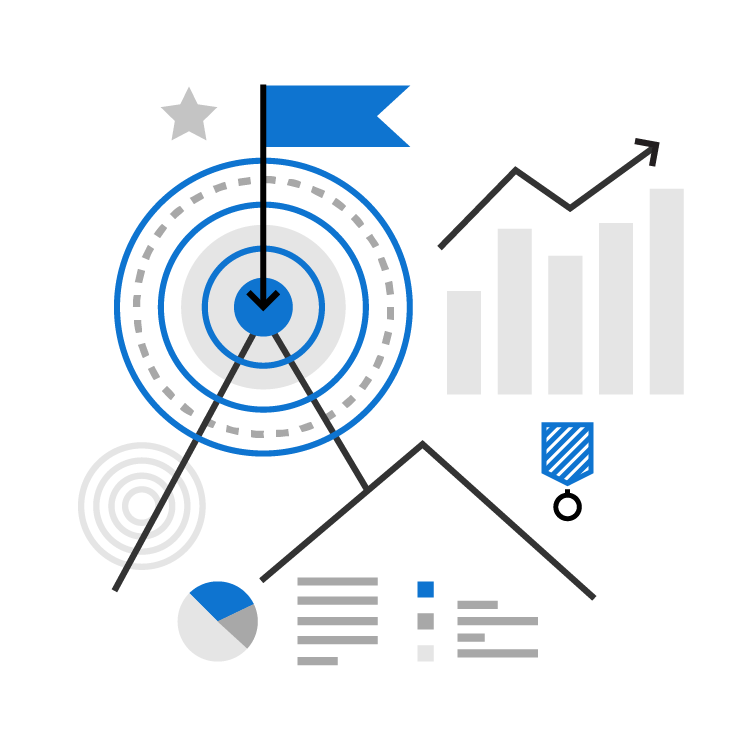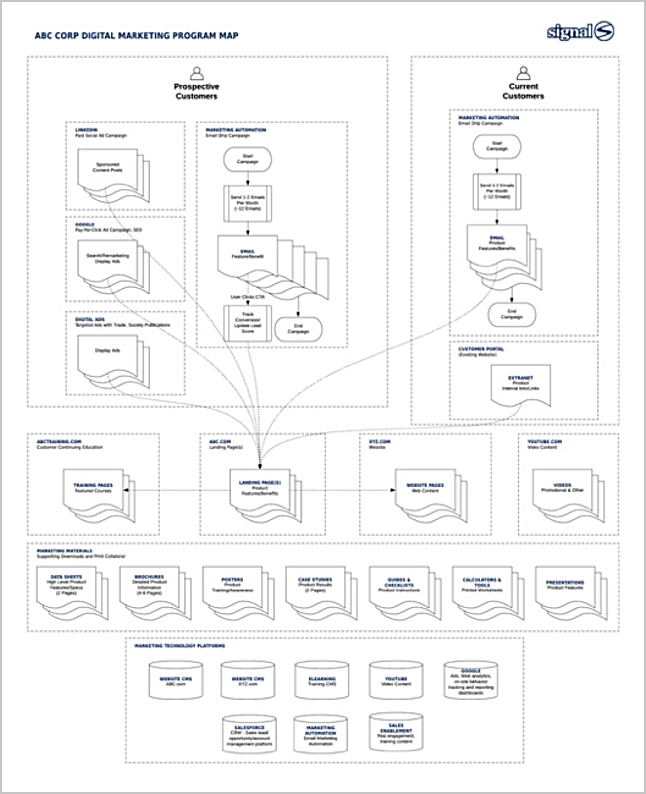
We often find that marketers are under such pressure to create and execute campaigns that they often don’t take a step back to clearly define and optimize their marketing strategy. Completing this fundamental step establishes a strong foundation for your entire program. Having this foundation allows you to build faster and more cohesive campaigns and to realize better results.
Signal developed a digital marketing framework to help our clients consistently showcase the value and benefits of products and services across key digital channels. This framework is designed to ensure campaigns are planned strategically and monitored consistently for maximum efficiency.
Completing this process will help your team:
- Establish your marketing program goals and define priorities
- Focus on the most effective use of your limited time and budget
- And forecast and evaluate campaign performance and ROI.
Step 1: Define Campaign Goals, Objectives & Constraints
Tools used: Program Summary, Program Map, Content Outline
Start by creating a Program Summary to catalog current and future campaigns:
| Name | Purpose | Budget | Start | End | Channels |
|---|---|---|---|---|---|
| General Awareness | Promote overall company awareness | $50,000 | Jan 1 | Dec 31 | Website, Email, LinkedIn, Search |
| Product X | New product intro | ||||
| Product Y Education | Product Training |
Establishing this bird’s eye view of your entire program clearly highlights your internal constraints (resources, budget, time) and can help your team prioritize campaigns and identify which dials to turn up and down. You’ll define the channels approach for each campaign, determining timing and assigning budgets.
Next, take inventory of what you’re doing and analyze any gaps.
Create a Program Map to give you a more granular and actionable view of your current marketing program. This flow chart will illustrate your marketing channels and how they are connected – how social, search, email and offline channels lead to landing pages and websites, and how those integrate with your marketing automation and CRM platforms, as well as other tools in your marketing technology stack.
Create your Content Outline, a simple catalog of your existing marketing assets – landing pages, print collateral, videos, case studies, and so on. This allows you to quickly see what content you can leverage and what gaps may exist, which is instrumental as you plan and build future campaigns.
| Item Name | Type | Related Content | Description | URL |
|---|---|---|---|---|
| ABC General Landing Page | Website/Landing Page | Product X, Product Y | Category homepage | abc.com |
| Product X Landing Page | Website/Landing Page | Product Y | Features and benefits | abc.com/productx |
| ABC Infographic | Infographic | Product X, Product Y | Infographic | abc.com/graphic |
| Product X Brochure | Brochure | Product Y | Download from landing page | abc.com/downloadx |
| Product X Sales Presentation | Presentation | Product Y | Links to all arterial sub-pages | abc.com |
| Product X Solution Article | Blog | Product X, Product Y | Product copy + features graphic | abc.com |
| ABC Corporate Video | Video | Product X, Product Y | Capabilities video | abc.com |
Step 2: Define Featured Offerings
Create a spreadsheet that lists your company’s products and/or services. Add positioning and categories for quick reference. This tool will allow your team to quickly prioritize campaigns with internal stakeholders.
| Product Category | Product | Priority | Related SKUs | Description | URL |
|---|---|---|---|---|---|
| Category X | Product X | 10 | 6 | Insert positioning and benefits | |
| Category Y | Product Y | 5 | 2 | Insert positioning and benefits |
Step 3: Identify Target Audience
Tools used: Personas and Customer Journey Maps
To be successful, you must thoroughly understand and connect with your audience. Creating customer personas and customer journey maps are critical to this process. These documents can be as formal as you want to make them, however, we recommend keeping it simple. Know that they are fluid, working documents and you can continue to refine them.We suggest first talking with internal stakeholders to paint a picture of the target customers. If possible, also talk with actual current and potential customers to validate any internal assumptions.

Mapping the Customer Journey goes hand in hand with defining your sales funnel. A Journey Map typically includes stages and corresponding types of content:
- Awareness Stage: blogs, infographics, social media posts, podcasts, short videos
- Interest Stage: eBooks, white papers, explainer videos, conversion landing pages, paid/display ads
- Consideration Stage: case studies, customer testimonials, sales emails
- Purchase Stage: on-location and in-studio video testimonials, sales collateral
The Journey Map also captures the customer’s goals, process, problems and KPIs at each stage of the journey to ensure the customer’s needs are clear and highlight key opportunities.
UXPressia Persona and Journey Mapping Tool
Step 4: Identify the Competition
You won’t know how to stand out in the market until you have a clear picture of the competition you’re up against. Understand the landscape, including market share and activity. The first time you do this, you can focus on keeping it high level.
- Positioning
- Visual impact
- Digital properties
- Strengths and weaknesses
- Calls to action
Doing this research will help you determine how you can compete and excel in branding, messaging, program offerings and content strategy. When you get into individual campaigns, you can begin to drill deeper into competition for that specific offering.
Step 5: Define How you will Measure Success
Tools used: Measurement Plan
How will you know if your marketing campaigns are successful? You need to define clear goals, determine KPIs and set specific targets to measure performance. Without a Measurement Plan, it will be difficult to monitor and optimize your campaigns to achieve the best possible results. Having a Measurement Plan also helps you set realistic expectations for the ROI of marketing efforts vs. simply focusing on increased sales revenue.
See Our Post on How to Create a Measurement Plan
What’s Next
Once you’ve completed these 5 steps, you have the necessary digital marketing planning framework and tools in place to chart your path forward. Now it’s time to confidently move into tactical campaign planning and execution.

Plan and execute each campaign by completing the following steps, referencing and continually refining the tools you’ve created:
- Select campaign channels
- Determine tactics and timing
- Prioritize budget across channels
- Set campaign goals and align measurement plan
- Develop campaign content and creative
- Launch
- Monitor and optimize
Ready to take your company’s digital marketing framework to the next level? The Signal team is here to help.






